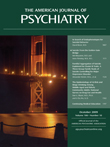Familial Aggregation of Suicide Explained by Cluster B Traits: A Three-Group Family Study of Suicide Controlling for Major Depressive Disorder
Abstract
Objective: There is substantial evidence suggesting that suicide aggregates in families. However, the extent of overlap between the liability to suicide and psychiatric disorders, particularly major depressive disorder, remains an important issue. Similarly, factors that account for the familial transmission of suicidal behavior remain unclear. Thus, through direct and blind assessment of first-degree relatives, the authors conducted a family study of suicide by examining three proband groups: probands who committed suicide in the context of major depressive disorder, living depressed probands with no history of suicidal behavior, and psychiatrically normal community comparison probands. Method: Participants were 718 first-degree relatives from 120 families: 296 relatives of 51 depressed probands who committed suicide, 185 relatives of 34 nonsuicidal depressed probands, and 237 relatives of 35 community comparison subjects. Psychopathology, suicidal behavior, and behavioral measures were assessed via interviews. Results: The relatives of probands who committed suicide had higher levels of suicidal behavior (10.8%) than the relatives of nonsuicidal depressed probands (6.5%) and community comparison probands (3.4%). Testing cluster B traits as intermediate phenotypes of suicide showed that the relatives of depressed probands who committed suicide had elevated levels of cluster B traits; familial predisposition to suicide was associated with increased levels of cluster B traits; cluster B traits demonstrated familial aggregation and were associated with suicide attempts among relatives; and cluster B traits mediated, at least in part, the relationship between familial predisposition and suicide attempts among relatives. Analyses were repeated for severity of attempts, where cluster B traits also met criteria for endophenotypes of suicide. Conclusions: Familial transmission of suicide and major depression, while partially overlapping, are distinct. Cluster B traits and impulsive-aggressive behavior represent intermediate phenotypes of suicide.



